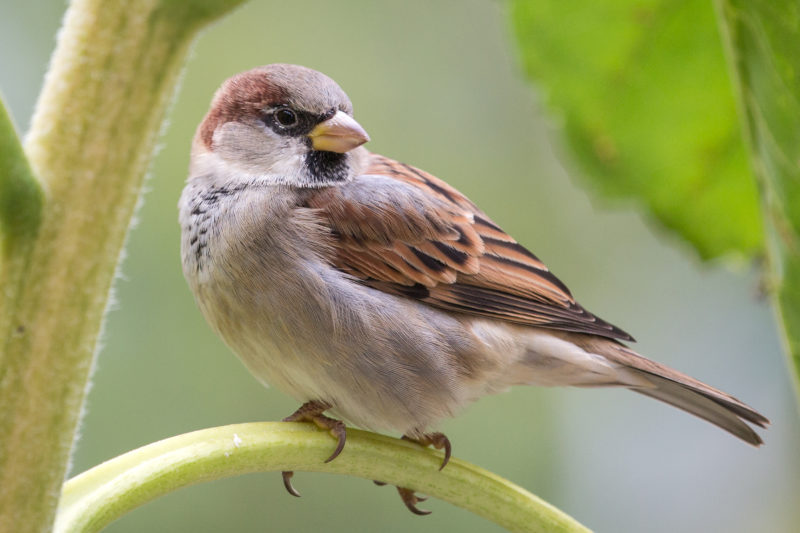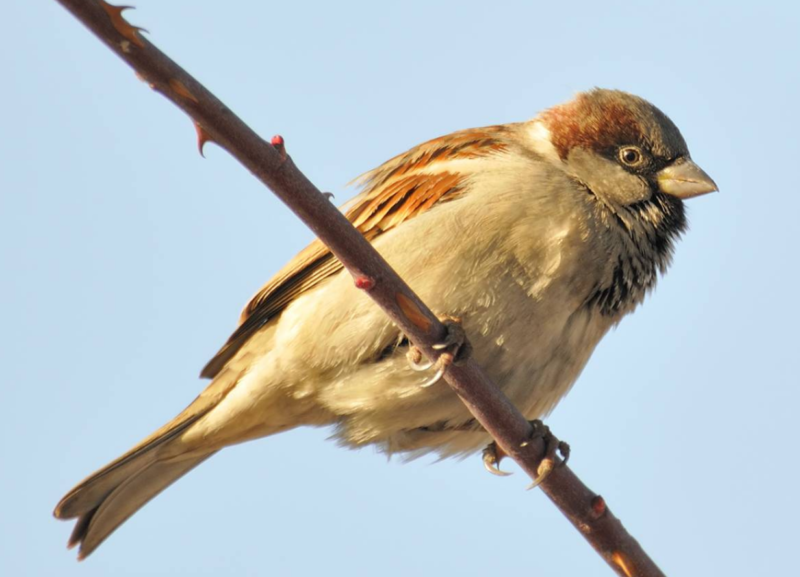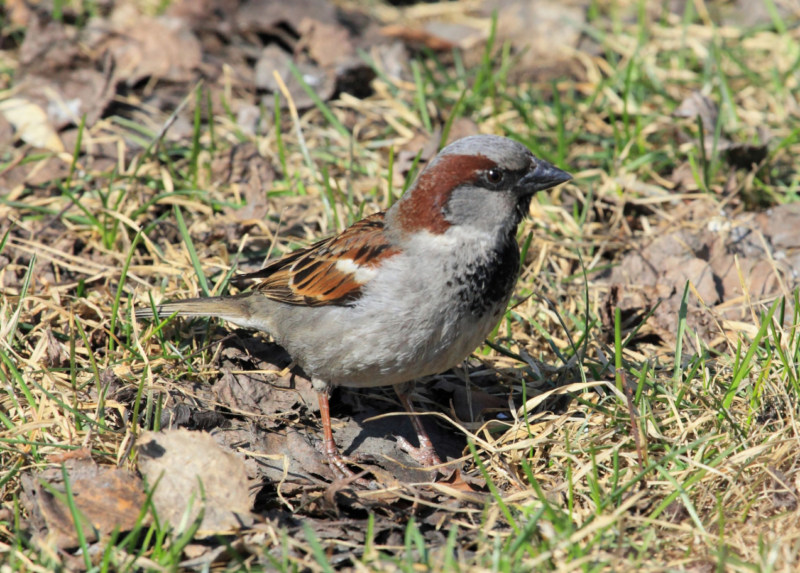For many people, this bird has become as much a necessary part of the natural environment as grass or clouds. House Sparrow is a synanthropic species, that is, an animal that lives next to a person in cities, villages, parks, gardens. A small, brisk bird is constantly in a hurry, fussing, does not walk, but jumps to keep up everywhere.
Material Content:
Bird species description
House Sparrow (Passer domesticus) is a common bird species. The body is 14–16 cm long and weighs an average of 30 g. Males and females differ in plumage color. The head of a male is large with a conical beak and a gray “cap”. The length of the wings is 7–9 cm, wingspan - up to 22 cm. Brown color with black longitudinal marks predominates in the color of the upper body. The underbody is ashen, the chest and neck are black or dark gray, on the wings are white stripes.
The plumage of a female house sparrow is less noticeable. The overall color is grayish-brown. The head and upper body are gray-brown, the back is black-brown. Young birds of both sexes are similar to females, only in males the feathers are lighter, with yellowness.
The house sparrow and its 12 subspecies belong to the family of sparrows. These are sedentary and nomadic birds. Such birds usually fly low, develop a speed of about 60 km / h. Try to stay close to the nesting site.
The description of the species of birds can be supplemented by the mention of the fact that on the ground a sparrow almost always jumps on both legs. It takes separate steps only next to a closely located object and when moving sideways on branches. He is able to climb vertical walls and tree trunks, leaning on a spread tail, sometimes on half-open wings.
In singing, “males” “practice” mainly.
The bird's voice is pretty monotonous - loud tweets and rhythmic twittering.Even sparrows emit clicking signals, which means they warn about enemies in the air and on the ground. In the mating season, future "spouses" use various sounds. If a house sparrow finds himself in the company of canaries, then he imitates their singing with his sharp and loud voice.
House Sparrow Habitat
These small birds are found everywhere, are absent only in the coldest and especially hot latitudes. The northern part of the range runs along the 60–70 parallel. Constant body temperature helps to survive in harsh conditions.
Birds of this species and subspecies prefer cultural landscapes. House sparrows flock in flocks in small and large settlements, in wastelands, near field roads. At a distance further than 2 km from the settlements are rare.
For the survival of the species, the year-round availability of seeds and the availability of suitable nesting sites are important. Ideal for poultry habitat - agricultural land, poultry farms, large parks and shopping centers.
The fitness traits of individuals are manifested in the ability to find food even in the most lean years, the ability to roam in search of places rich in food. Sparrows are not particularly shy, but do not let a person get close to themselves, skillfully avoid meeting with cats.
Nutrition, lifestyle
The main food of the house sparrow is seeds, primarily wheat, barley and oats. Cereals account for 70% of the poultry diet. Seeds of wild herbs, berries, fruits are eaten. Insects play an important role in nutrition in spring and summer. In the warm period, they make up to 30% of their total menu.
Sparrows in the city are omnivorous birds.
In the early days, parents feed the chicks with caterpillars chopped by larvae. If you treat babies with bread, then this can cause indigestion and death of the cubs. At an older age of the chicks, the proportion of plant components increases to 30%.
Sparrow is an outgoing individual, lives in packs and groups.
The behavior and "daily routine" of each individual depends on the life of relatives. Birds begin to tweet several tens of minutes before sunrise, are active during the day and at dusk. On the fields of grain sparrows feed in flocks of 20 individuals. First, one bird finds food and lures the rest with special cries.
Sparrows protect the nesting and sleeping place from strangers. Birds take dust baths in turn to protect them from parasites, and clean feathers after bathing. Collisions between “friends” most often occur at feeding and nesting sites. Mostly males conflict.
Breeding birds
The house sparrow reaches puberty at the end of the first year of life. The breeding season in the European part of the range begins in April and lasts all summer. There are 2-3 broods per season. The birds create pairs, but there are also cases of "polygamy."
When choosing a partner, the female prefers the one who chose the most protected place for the nest and tweetes louder.
Birds look for nesting sites individually or in colonies. Between females incubating egg laying, there should be a distance of at least 0.5 m. Sparrows arrange their dwellings in niches and crevices in the wall laying, under eaves, canopies. They build nests in birdhouses, hollows, less often - on trees and shrubs.
In one clutch, usually 4-6 eggs weighing about 3 g. Shell color from white to pale gray or greenish with brown spots. In the brood, the last hatched chicks are usually larger.
Value for man
Previously, sparrows were treated only as pests of agriculture. This was due to the fact that in autumn and winter birds feed on cereals. In addition, in the past, sparrows were more numerous, they really caused a certain damage to agriculture. In the 18th century, King Frederick the Great of Prussia awarded a reward to someone who would find a way to protect the fields from invasions of feathered pests.
After World War II, birds were poisoned with poisonous grain, and toxic substances were used against them. All these measures led to a sharp reduction in the number of sparrows - brownie and field.
Nowadays, these birds are considered as natural reservoirs-hosts of various arboviruses, carriers of Salmonella and pathogens of other diseases.
Sparrows themselves are in mortal danger in the vicinity of humans. During the breeding season, up to 50% of adult birds die. The enemies of birds - martens, cats and dogs. Kestrel sparrows are hunted, a barn owl, a sparrow hawk.
Ornithologists consider the reason for the decrease in the number of birds to be a lack of places for nesting and feeding. In cities, continuous development prevails, buildings in which there are no niches and cavities. The fields use modern combines, after which there is no grain left. Natural vegetation is replaced by flowers and ornamental shrubs.
What is the difference between house and field sparrows
These are closely related bird species, widespread throughout the world. Sparrow, in contrast to the house sparrow, is more often found outside settlements, less associated with human dwellings. There are also differences in body size and plumage coloring.
A sparrow is more elegant than a brownie, has a brown “cap” on its head, black spots on white cheeks. The black “bib” is smaller than that of the house sparrow; a white “collar” stands out on the sides of the neck. Females and males do not differ from each other.
Two species compete with each other. Brownie and field sparrows do not form mixed flocks, kept separately.


















